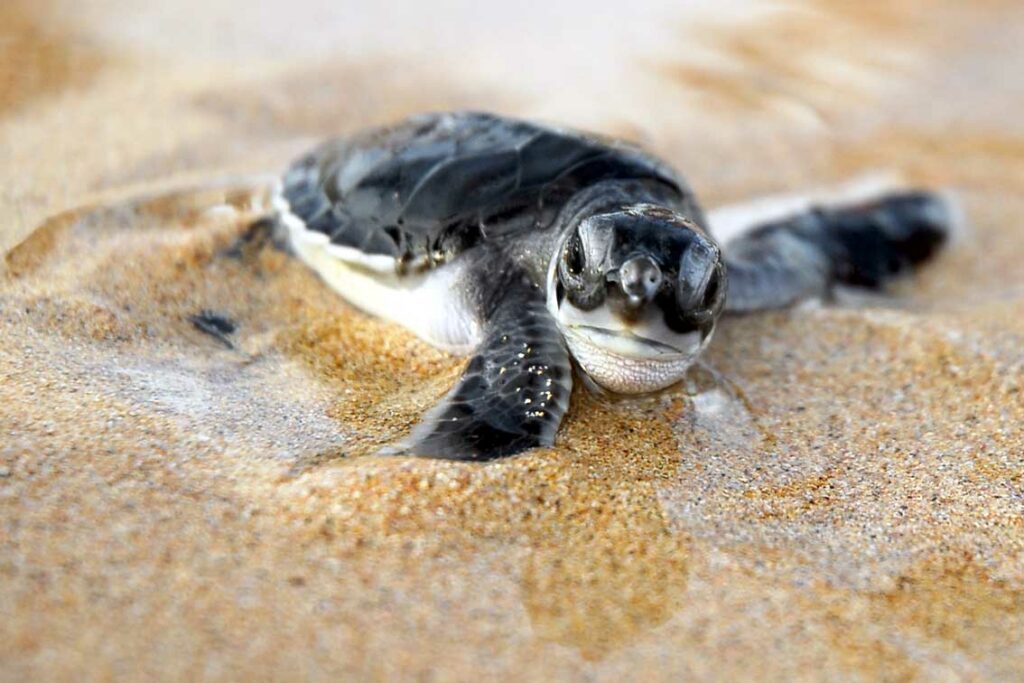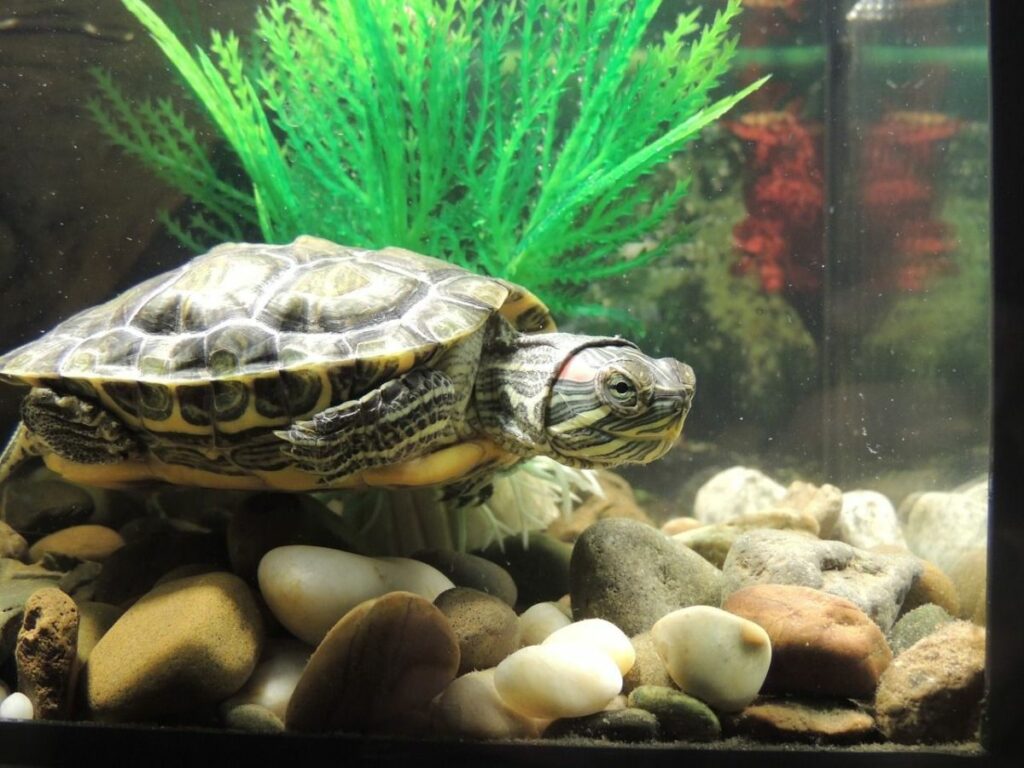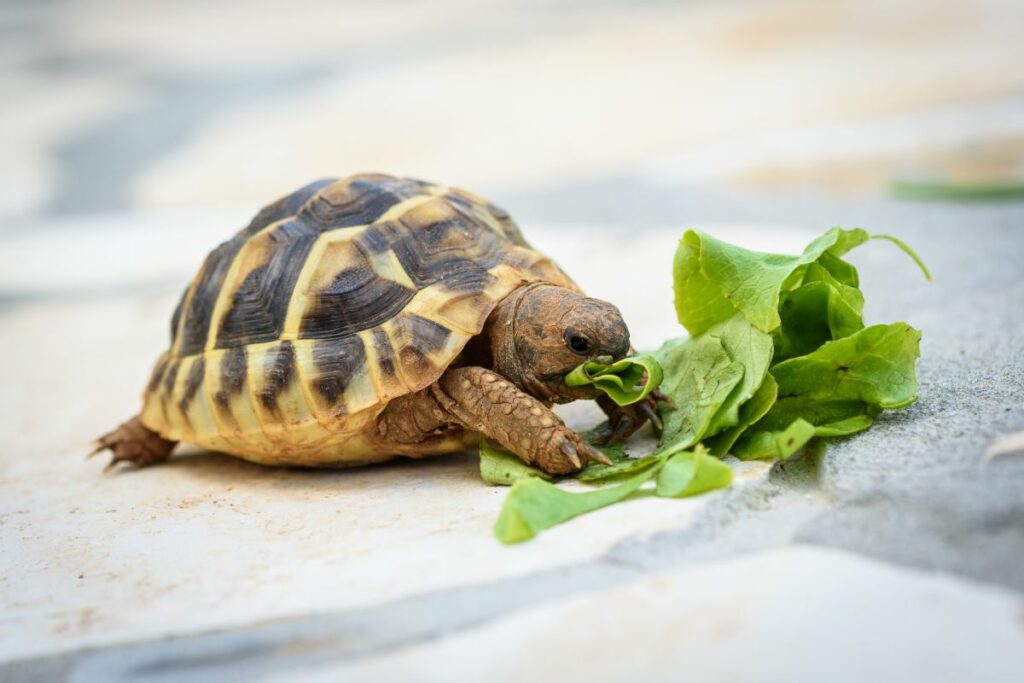A baby turtle needs a lot of care. Baby turtles are adorable, but they’re more difficult than adults.

You’ll want to have the right set-up, the right feeding routine, and the right lighting and temperature.
How To Take Care Of A Baby Turtle
A newborn turtle is difficult to take care of because its needs are specific.
Turtles are wild animals and are not domesticated. They do not like handling, and they become stressed easily.
Plus, turtles can carry diseases. The smaller the turtle, the more likely it is to carry salmonella. So, you need to take care when handling them.
What Do Baby Turtles Need?
Before attempting to care for a baby turtle, you’ll want to have the right equipment:
- Tank (aquatic) or enclosure (terrestrial)
- Filter (for aquatic turtles)
- Water heater (for aquatic turtles)
- Substrate
- Raised basking area
- Heat lamp
- Lighting
- Decorations
- Food
The turtle itself may not cost much. But, the total price of the turtle adds up when you consider all it needs for care.
You’ll also need to consider the cost of food and vet care. Most people spend about $50 a month on turtle food.
When you first get your turtle, you’ll want to take it to the vet for an assessment. You don’t need to bring turtles to the vet regularly like you do a cat or dog. But, if something goes wrong, exotic vets are often hard to find and costly.
What Kind Of Tank Or Enclosure Do They Need?

A baby turtle tank should be at least 15-20 gallons so they have ample space to move around. But, turtles grow quickly, so it makes sense to start with a larger aquarium in the first place.
Research what size tank your turtle needs as an adult. Depending on their adult size, they will need a tank of anywhere between 30 to 100+ gallons. Terrestrial turtles often need even more space than that.
Aquatic turtles need a water-tight aquarium. Terrestrial turtles can live in glass aquariums, mesh terrariums, rabbit cages, or homemade enclosures.
What Kind Of Substrate Is Best?
For aquatic turtles, you can keep the bottom of the aquarium bare if you wish. You can also choose sand, pebbles, or substrate made specifically for turtles. If you choose pebbles, be sure they are too big to fit in your turtle’s mouth
Terrestrial turtles do best with coco coir or coconut fiber. To help with humidity, or simply for decoration, you can add sand or peat moss. Turtle-safe mulch is also available.
What Temperature Do Turtles Need?
Proper lighting is essential to maintain the health of adult and baby turtles. The wavelengths of a UVB bulb keep your turtle’s shell and bones strong.
You’ll also need a separate heating lamp to keep in your turtle’s preferred basking area. The basking area should be in the corner of the tank. This gives your turtle the option to walk away and cool off when needed.
A basking area is essential for both aquatic and terrestrial turtles. For aquatic turtles, keep the basking area raised above the water line. Always ensure the basking area is at least 12 in (30.5 cm) from the heat source so it doesn’t burn your turtle.
Many heat lamps do not provide any lighting. They consist of ceramic that only emits heat. If you prefer, you can get a bulb that emits red light. Red bulbs allow you to see your nocturnal turtle at night without bothering them.
Keep both the basking area and the water for swimming at about 86 ° F (30°C).
How Much Water Does A Baby Turtle Need?
Baby water turtles need plenty of room to swim around, but take care that the water isn’t too deep. Measure the width of your turtle’s shell and fill the tank about 1 in (2.54 cm) taller than the width.
For aquatic turtles, you’ll also need a filter to keep the water clean. Some filters are made specifically for turtle tanks. They are often easier to install in the enclosure. You can also buy a large fish tank filter.
Terrestrial turtles need water, too, but a shallow drinking dish or wading pool will suffice.
How Often Should I Feed My Turtle?
Baby turtles need feeding more often than adults. Adults only need to eat once a day to once every few days. A baby turtle needs to eat 2-3 times a day.
How To Feed Baby Turtles

All turtles are omnivorous. Both terrestrial and aquatic turtles can eat the same kinds of foods. But, terrestrial turtles eat more veggies while aquatic turtles need more protein.
According to VCA Animal Hospitals, this is how you should feed veggies to your turtle:
“The plant portion of the diet should be made up of vegetables, preferably ones that float and can be left in the water for the turtle to nibble on throughout the day. Leftover food should be scooped out of the tank daily to promote proper hygiene. Desirable vegetables to offer include dark leafy greens such as romaine lettuce, collard greens, mustard greens, carrot tops, endive, Swiss chard, kale, parsley, green beans, dandelion greens, turnip greens, and clover. Iceberg or head lettuce should not be fed, as it is comprised mostly of water and contains very little nutritional value.”
Hatchling turtle food should also consist of some fruits, commercial turtle food, and protein.
Baby turtles have higher protein requirements than adult turtles. Good proteins include feeder guppies, crickets, and aquatic shrimp.
A turtle baby may also need some supplements to help it grow and stay healthy. Calcium and vitamin D supplements help keep their shell and bones strong.
Conclusion
Raising turtles can be hard, but it’s rewarding. If you’re going to keep baby turtles as pets, you’ll need the proper enclosure, food, and environment. Provide them with plenty of nutritious foods and supplements. Doing so helps them grow into happy, healthy adults.
FAQs
In the wild, turtles do not receive care from their parents and are on their own as soon as they hatch. So, it’s necessary for baby aquatic turtles to know how to swim immediately.
A baby turtle is called a “hatchling” because it hatches from an egg. A group of baby turtles or their eggs is called a “clutch”.
Newborn turtles look like miniature versions of their adult form. Baby turtles have to fend for themselves immediately upon hatching. So, they need to have the same abilities as adult turtles. Still, their coloration may be different. Many young turtles are more brightly colored than their adult counterparts.
How many hatchlings survive to adulthood varies by species, but in general, the odds aren’t good. Turtle eggs are easy prey for hungry animals. Once they hatch, a turtle’s odds aren’t much better because they’re very small and mostly defenseless.
The National oceanic and atmospheric administration (NOAA) says a baby sea turtle’s chances are grim:
“On the beach, hatchlings must escape natural predators like birds, crabs, raccoons, and foxes to make it to the sea. Once in the water, hatchlings are consumed by seabirds and fish. Few survive to adulthood, with estimates ranging from one in 1,000 to one in 10,000.”
Freshwater turtles seem to have better luck with survival rates averaging about 20-30%.
Turtles are one of the more difficult pets to take care of due to all their requirements. They need ample space, access to water and land, the perfect lighting and temperature, etc.
Still, some species are easier to care for than others, so you needn’t be nervous about taking care of them. Just be sure to do the proper research before choosing a turtle. Turtles can make great pets, even for beginners.
Where you can get a baby turtle depends on where you live. In many places, you can get your baby turtle from a local pet store or breeder. You can even buy them online and have them shipped to you.
In some places, it may not be legal to keep a baby turtle. The United States, for instance, has a ban on owning turtles under 4 in (10.2 cm). The ban isn’t well regulated, so many breeders still sell babies. Still, the ban is to prevent the spread of salmonella. So, to avoid doing anything illegal, it’s better to buy a turtle that is more than 4 in (10.2 cm) in length.
Wherever you choose to get your turtle, ensure the breeder is reputable. Research the breeder beforehand to ensure the health and quality of the turtle you’re buying.
